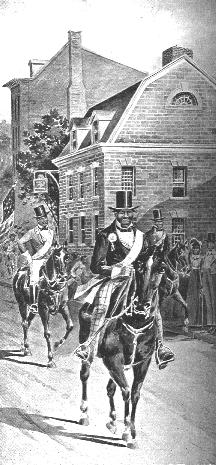Emerging from the Shadows, 1775-1819:
The Black Governors |
|---|
In a previous section, there were discussed the
petitions of liberty, which suggests that white insitutions
might possibly be used to better the condition of Blacks as a whole. This incipient political development was
probably why in the course of the eighteenth century the ruling class began to realize that individual relations
of dominance were insufficient, and there was need of some way to control Black communities as a whole.
This was achieved, as is so often the case, by coopting individuals from the Black communities to act as
mediators. These individuals, who were raised from the Black communities to help whites maintain control
over them, were the "Black Governors."
 The office of Black Governor originated in Massachusetts and then appeared in Connecticut and Rhode
Island. These officials served as mediators between the white establishment and the communities of
Blacks. As such they could appear in ceremonies as heads of their communties, or carry out various
judicial and religious functions. While they might be elected, this does not imply they were agents of the
Blacks who elected them, but only that they commanded enough respect to be heeded. In white society
as well, politics was dominated by local notables whose basic function was social control in the interest
of the ruling class.
The office of Black Governor originated in Massachusetts and then appeared in Connecticut and Rhode
Island. These officials served as mediators between the white establishment and the communities of
Blacks. As such they could appear in ceremonies as heads of their communties, or carry out various
judicial and religious functions. While they might be elected, this does not imply they were agents of the
Blacks who elected them, but only that they commanded enough respect to be heeded. In white society
as well, politics was dominated by local notables whose basic function was social control in the interest
of the ruling class.
Some Black Governors had assistants and sheriffs, which shows that they had substantial responsibilities
and were not merely figureheads. Shown is a reproduction of a painting by H. P. Arms c. 1905, from a
Connecticut Magazine article, "The Building of Model Municipality," Vol. IX, no. 3. It shows a
"Parade of the 'Black Governors' in Hartford." The picture does not show the Governors in a very
sympathetic light, but their function in early Hartford, after all, was to hand out severe and summary
punishment to slaves who had violated the law, and this probably did not make them much loved in
the Black community.
Here is a table of known Black Governors, and it probably indicates
roughly the relative size of Connecticut's Black communites. If so, Hartford's would seem to have been
the largest. The last Black Governer in Hartford that we know of is the same Boston we encountered
before.
| Name |
Location
| Approximate date |
|---|
| Quash Freeman |
Derby |
1810 |
| Tobias |
Derby |
1815 |
| Roswell Quash (Freeman?) |
Derby |
1830-1835 |
| Eben Tobias |
Derby |
1840-1845 |
| Caesar |
Durham |
1800 |
| Peter Freeman |
Farmington |
1780 |
| London |
Hartford |
1755 |
| Quaw |
Hartford |
1760 |
| Cuff |
Hartford |
1766-1776 |
| John Anderson |
Hartford |
1776 |
| Peleg Nott |
Hartford |
1780 |
| Boston |
Hartford |
1800 |
| William Lanson |
New Haven |
1825 |
| Quash Piere |
New Haven |
1832 |
| Thomas Johnson |
New Haven |
1833-1837 |
| Boston Trowtrow |
Norwich |
1770 |
| Sam Huntington |
Norwich |
1772-1800 |
| Jubal Weston |
Seymour |
1825 |
| Nelson Weston |
Seymour |
1850 |
| Wilson Weston |
Seymour |
1855 |
| London |
Wethersfield |
1760 |
| Cuff |
Woodbridge |
1840 |

![[Exhibit contents]](../../bin/top.gif)
![[Back]](../../bin/back.gif)
![[Forward]](../../bin/forward.gif)
|